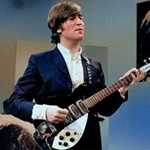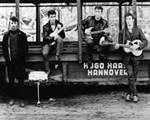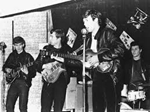- Register
- Log in to Tune-In
- Wishlist (0)
-
Shopping cart
(0)
You have no items in your shopping cart.
Beatles News

George Harrison wrote "Something," arguably one of the greatest love songs in music history, about his first wife, Pattie Boyd, but their marriage didn't stand the same test of time as his lyrics and melody: The pair divorced after Boyd left Harrison, a Beatle, for Eric Clapton, a guitar god. And that wasn't even the only love triangle to plague the couple's marriage. According to Boyd, Harrison cheated on her with his bandmate Ringo Starr's then-wife Maureen Starkey (no, really!). That's a lot of drama for a man known as the "quiet Beatle."
Keep reading to learn more about Harrisons wives, including who he was married to at the time of his death in 2001. Harrison was married two times: first to Pattie Boyd, from 1966 to 1974, then to Olivia Harrison, from 1978 until the time of his death in 2001. How did George Harrison and Pattie Boyd meet?
Boyd was 19 and just starting her modeling career when she got a small part as a school-aged Beatles fan in the 1964 film A Hard Day’s Night. Harrison was immediately smitten with the young woman and asked her to dinner, but she politely declined because she was seeing someone else at the time. A week later, newly single and back on set for details

Have you met the Beatles? The odds are you have, whether you grew up with them, sought them out, or were never formally introduced. You may know the name, at least, even without having heard the numbers, as one knows Shakespeare’s without having read or seen a play, or even knowing he wrote them.
The Fab Four — phenomenal in their time, phenomenal after. Though they made their split official in 1970 after coming apart in bits and pieces, they have never gone away. As long as John Lennon lived, there was always the possibility of the band getting back together — in a classic “Saturday Night Live” bit, Lorne Michaels offered them $3,000 to reunite on the show — and his death, and the global consciousness of loss, launched an era of revived Beatles awareness, of finding new things to do with the old music, protecting the legacy and promoting the brand.
With the band’s recorded catalog lately being remixed, remastered and rereleased, in special editions with extra tracks, it was only logical that Apple would get around to the movies. Peter Jackson’s “Get Back,” his six-hour AI-enhanced cut of footage shot during the making of the album “Let It Be,&rdq details

Yoko Ono is spending her final years in reflective seclusion, far from the spotlight she once craved, with sources telling OK! she now believes she has changed the world and now wants the peace of watching it from a distance.
The avant-garde artist, musician and activist – who stalked John Lennon before they met – has retreated from public life decades after rising to global fame in the 1960s and meeting Lennon, whom she married in 1969.
Their personal and creative partnership, forged after they met at Ono's London art exhibit in 1966, reshaped cultural and political activism in the early 1970s as the couple settled in New York City. The pair welcomed their son Sean in 1975, made boldly experimental music, and became fixtures of anti-war and civil rights campaigns.
But Ono's world changed irreversibly on December 8, 1980, when Lennon was shot and killed outside their Upper West Side home as she stood nearby.
Yoko Ono said she missed her husband's 'tenderness' after he was shot. Ono later said about his assassination by unhinged fan Mark David Chapman: "What I miss most about John is his incredible tenderness and his belief in me ... love can sometimes be h---. You could abuse eac details

The newly refurbished version of “The Beatles Anthology” has been rolling out on Disney+ over a period of days this week, with a newly commissioned Episode 9 premiering on the service Friday night. It gives the epic 1995 docuseries more than just a new edit and a fresh set of paint: it gives it an all-new finale that feels sweeter than the way the original project faded out with the gradual breakup of the most popular band of all time. And fans aren’t likely to mind the extra hour’s worth of either added context or additional sentiment.
With the new episode about to premiere, its director, Oliver Murray, told Variety about his intentions for this fresh finale. He’s the same man whom Apple Corps drafted to a short movie about the “final Beatles single,” “Now and Then,” when that was unveiled two years ago. Even though he was not yet a teenager when the original “Beatles Anthology” first aired in prime time 30 years ago, Murray was considered the right candidate to draw together footage that was shot at the time with Paul McCartney, George Harrison and Ringo Starr. The three ex-Beatles became active Beatles once again at that point in drafting old John Lenn details

Before The Beatles came around, singles ruled the roost in terms of rock and roll importance. The band started to change that. Their ability was such that even their non-singles rivaled or surpassed the quality of their contemporaries’ biggest hits.
Because these four songs are so popular, you might think they were huge smashes. But The Beatles never even released them as singles.
“In My Life”
In the first half of their recording career, The Beatles, for the most part, released singles in the United Kingdom that didn’t appear on their albums. In turn, they usually reserved the albums for songs that wouldn’t get a single release. This wasn’t a hard and fast rule. But it did mostly account for brilliant songs like “In My Life” only getting exposure via LP. The song could easily have been another No. 1 for the group, as it’s one of the most beautiful, affecting ballads ever written. Of course, it wasn’t long before people who heard it realized its brilliance. It has received a ton of cover versions over the years as well. But none of them match the unaffected lead vocal of John Lennon on the original.
“A Day In The Life”
When details

The Beatles’ Anthology 4 dropped on November 21, adding another volume of outtakes and rarities to the three Anthology albums released in the 1990s. Now, as the Anthology docu-series returns to screens this week — along with a revealing new Episode 9 — it’s worth remembering that the group churned out a core catalog of 213 songs between 1962 and 1970.
That’s a lot of tracks in just eight years. And, as you might imagine, the Beatles themselves weren’t fans of everything they produced.
That goes double for John Lennon. In the latter years of his career, the most critical Beatle took a particularly dim view of many songs in the group’s catalog, including his own.
His most withering condemnations were saved for the songs he stamped out in cookie-cutter form or peeled off as nonsensical filler. "It's Only Love" is an example of the former, a Help! track he called “abysmal”, while the latter includes Abbey Road's "Mean Mr. Mustard," a bit of light-hearted fluff he denounced as “a piece of garbage.”
And then there's the song Lennon called his “ details

Part of the magic of John Lennon and Paul McCartney’s songwriting partnership was their ability to blend the former’s avant-garde experimentation with the latter’s commercial sensibilities, and few singles demonstrate this ability—for better or worse—as the 1967 A-side “Hello, Goodbye” and its B-side, “I Am the Walrus”.
Unsurprisingly to anyone with even a vague knowledge of The Beatles, McCartney penned “Hello, Goodbye”, and Lennon wrote “I Am the Walrus”. Both songs are indicative of who each musician was as a songwriter. McCartney explored Gemini-esque themes of duality amidst a pop background, Lennon composed an LSD-fueled ode to Lewis Carroll poetry with nonsense syllables and shocking imagery.
Also unsurprising is the fact that Lennon wanted “I Am the Walrus” to be the A-side to the single. Ultimately, McCartney and George Martin won the debate, and Lennon’s psychedelic ode to the “egg man” was relegated to the B-side. McCartney and Martin were correct in their assumption that “Hello, Goodbye” would perform better on the charts worldwide, though “I Am the Walrus” beat out its details

The early notion of the Beatles as “four lads that shook the world” has been subject to many shifts in emphasis over the decades. They have been valorised, vilified, mythologised, misunderstood and even ignored. The release this month of the new Beatles Anthology – an expansion of the original mid-1990s compilation with CD, vinyl reissues and the documentary series streaming on Disney+ – is testament not just to their enduring appeal but also to how the constant reframing of their story reveals as much about our changing tastes. The 2025 edition arrives as a full-scale revisitation of the original project, bringing with it a remastered, expanded documentary series and a substantial reissue campaign.
What is more likely to reshape the way we see the band, though, is the addition of a brand-new ninth episode to the original TV series, built from recently excavated footage of Paul McCartney, George Harrison and Ringo Starr working together in 1994–95. Far more intimate and informal than the original broadcast, this material captures the three surviving Beatles rehearsing, reflecting and simply spending time as old friends rather than cultural monuments, albeit still with the “kid brother details

In late November 1968, over Thanksgiving weekend, George Harrison went to Bob Dylan‘s home in Bearsville in Woodstock, New York, for a few sessions. At the time, Dylan was going through a period of low confidence, following his motorcycle accident two years earlier, shortly after the release of Blonde on Blonde, and had retreated from touring until 1974, when he went out again with the Band.
“Bob Dylan had gone through the thing of breaking his neck in a motorcycle accident and being out of commission for a time,” recalled Harrison in his 1982 memoir I, Me, Mine. “He’d got himself back together and had finished ‘Nashville Skyline’ shortly before I arrived there. I was hanging out at his house, with him, Sarah and his kids. He seemed very nervous, and I felt a little uncomfortable—it seemed strange, especially as he was in his own home.”
During this period, Dylan also recorded The Basement Tapes with the Band, along with his eighth album, John Wesley Harding (1967), followed by Nashville Skyline in ’69. Though Dylan had already been linked to another Beatle, John Lennon, he also developed a close friendship with Harrison during their Thanksgiving session details

Since 1960, the Beatles—four fabulous lads from Liverpool, England—have remained the greatest rock and roll band in the history of music. How John Lennon, Paul McCartney, George Harrison, and Ringo Starr managed to make music together remains a mythical truth over half-a-century later. From Please Please Me to Abbey Road (or Let It Be, commercially), the quartet have influenced thousands—likey millions—of people to pick up an instrument and start writing songs. Without the Beatles, the DNA of modern music as we know it would look unrecognizable.
We first ranked the 50 best Beatles songs nearly a decade ago, and in 2023 we remade the list and took out 20 entries. Now, because opinions change like the day, and because the band is always present and relevant in the zeitgeist, we’re giving the ranking another upgrade. Maybe in two years I’ll bump it up to 100 entries. The popularity of albums and tracks are firmly in flux, and our ranking sets out to illustrate that. I didn’t want this list to look like an obligation. Instead, I hope you can feel the genuine love we have for this band in the order we’ve presented. So, we’ve pulled together a blend of the usual suspects a details

Steven Soderbergh directs a documentary using John Lennon's last radio interview. The film emphasizes Lennon and Ono's openness and relevance of their discussion. Lennon was tragically killed hours after the upbeat interview session.
Just before his life was cut short on December 8, 1980, John Lennon spent the day giving a remarkably open radio interview. Now, director Steven Soderbergh is bringing that conversation to life in a new documentary that explores Lennon’s final hours in his own words.
Soderbergh spoke with Variety about the upcoming film, which centers on the interview Lennon and his wife Yoko Ono recorded that fateful afternoon on RKO Radio.
“I’m excited about it… The job is to obviously present it in such a way that it enhances the interview and doesn’t distract from it,” he said. “I’m just hoping to create a film that gets as many people as possible to hear what John and Yoko had to say on that afternoon before he was killed.”
The Oscar-winning director said he was struck by how Lennon and Ono “were both so free in their discussions.”
“I was surprised at how open and excited they details

In the middle of the celebration at TD Coliseum in Hamilton, playing the longest list of greatest hits any artist has ever had, Paul McCartney paused to talk about Blackbird.
That’s the song he wrote after being inspired by the civil rights movement in the United States in the 1960s. On Friday night, in front of a sold out crowd, he told the story of how the Beatles were asked to play a show in Jacksonville, Fla., in 1964.
The promoter said the show was segregated. Black people on one side and white people on the other. The Beatles refused, McCartney recalled, saying "well that's stupid... and he must have realized there was a bit of money involved so he integrated the show. It was the first one."
McCartney led the grateful crowd on his magical history tour starting in Liverpool and their first number one hit single, From Me To You, with stops at the first song the Beatles ever recorded, In Spite of All the Danger and the first song they played for legendary producer Sir George Martin, Love Me Do.
He paid tribute to his Beatles bandmates, John Lennon, George Harrison and Ringo Starr. He played 1982's Here Today that let him say how much he loved and missed Lennon, easier than saying it in p details

Back in the mid-1990s, The Beatles released an eight-part Anthology series featuring John Lennon, Paul McCartney, George Harrison and Ringo Starr telling their own story outside of the traditional narrator and talking heads structure.
The series was accompanied by three volumes featuring the Fab Four’s albums, complete with all sorts of extras, and an official Anthology book.
Following the recent re-release of all three with extended content is Anthology 4, a special addition featuring “13 previously unreleased demos and session recordings and other rare recordings.
"It also includes new mixes of The Beatles’ Anthology-associated hit singles: the GRAMMY-winning Free As A Bird and Real Love, given new life by their original producer, Jeff Lynne, using de-mixed John Lennon vocals.”
Released today, the 36-track Anthology 4 can be listened to below on Spotify or purchased as a CD & Vinyl here. But that's not all.
The original Beatles Anthology documentary series is set to hit Disney+ with a three-episode premiere on November 26.
Restored by Peter Jackson's team, a brand-new ninth episode has been created for this new presentation, too. Beatles fans rejoice! details

Some mental images are inextricable from The Beatles’ legacy, not the least of which include John Lennon holding down rhythm guitar, Ringo Starr smiling and head-wagging behind the kit, Paul McCartney plunking out bass lines on his Hofner viola bass, and George Harrison playing lead guitar. But all that could have looked remarkably different—perhaps excluding Harrison altogether—if it wasn’t for one particularly bad bout of nerves at a show.
Bass players are often also guitar players, and McCartney is no exception. Songs like “Blackbird” and “Yesterday” proved that Sir Paul could work his way around a fretboard years before he would establish Wings, the band in which he played the most guitar. And as one of The Beatles’ principal songwriters, it stands to reason that McCartney might have ended up on lead guitar. At least, that’s what they were planning on in their earliest days of playing out.
As McCartney recalled in a 2025 edition of Anthology, he had a guitar solo on deck during his first gig with The Quarry Men. The young musician planned to take the lead on “Guitar Boogie”, but when the time came for his feature, McCartney’s hands details

Harry Lloyd, the British actor best known for playing Viserys Targaryen in the first season “Game of Thrones,” is set to portray George Martin in the upcoming four-part Beatles biopic by director Sam Mendes.
Lloyd joins Paul Mescal as Paul McCartney, Harrison Dickinson as John Lennon and Barry Keoghan as Ringo Starr and Joseph Quinn as George Harrison in Sony Pictures‘ “The Beatles — A Four-Film Cinematic Event,” due for release in 2028.
The casting is being revealed by Martin’s son, Giles Martin, in a pre-recorded interview going out on the Ryan Tubridy Show on Virgin Radio U.K later on Friday. “He’s really good. He’s very committed,” he said. Variety has since confirmed the casting with the production.
A classically trained musician, Martin was commonly referred to as the “fifth Beatle” for his extensive involvement in each of the band’s original albums. He wrote most of the orchestral and string arrangements and also played piano or keyboards on a number of their tracks. Once described as “the world’s most famous record producer,” across a 60-year career Martin produced 30 number one hit singles in U. details
